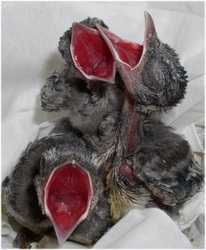

When given a choice, the bird will eat smaller red or blue fruit and avoid green and yellow fruit. In the winter, waxwings eat mostly cedar berries. The amount of berries taken in will decrease in May, since the fruit crops tend to wither then. They eat a variety of berries including juniper, dogwood, and wild cherries (Audubon).

The enzyme responsible for digesting the sugary foods is sucrase-isomaltase (Witmer and Rio). The fruit that they prefer are processed quickly in the gut. Waxwings differ from birds who focus on a high protein diet. The waxwing survives mostly on the intake of berries and are considered one of the most frugivorous birds in America. Cedar waxwings benefited from the harvesting of northern tolerant hardwood forest, partly because they prefer shrub like habitats (Holmes, Stephen B and Doug G. They also can be seen in open woodlands, hedgerows, suburban gardens, and orchards (Wildscreen). They normally prefer a wooded edge that has a source of water and berries (Cosley Zoo). Together in a flock, they fly from place to place to find food. They are not territorial nor aggressive (Witmer, Mountjoy, and Elliot). They are very social species with the largest flocks during the winter. Waxwings are usually always seen in a flock, even during breeding season. The waxwing practices self-maintenance by cleaning feathers with its beak and stretching their wings. Rarely seen on the ground, the cedar waxwing moves around branches with quick little hops. Waxwings will usually have two nests a year (Audubon), starting the nesting process between June and August (Klein) The baby birds normally leave the nest between fourteen to eighteen days after hatching. Eggs are glossy, greyish blue with brown and grey spots (Wildscreen). Both the mother and the father feed the baby waxwings. Waxwings prefer to nest in denser vegetation, which helps them avoid predation since waxwings do not have an aggressive defense style for their nests (Murphy and Cummings).Ī clutch consists of four to five eggs that are incubated for twelve to fourteen days. Nests are built in trees such hawthorns, white pines and apple. Construction takes up to five or six days to finish and requires more than 2,500 trips to the nest (Wildscreen). They will select soft materials such as grasses, pine needles, hair, moss and strings for the inner layer and twigs for the outer layer of the nest. Nests are built on straight limbs that are no more than fifty feet above the ground (McWilliams). The female then chooses a nesting site and nest construction will begin (National Wildlife Federation). The female will pass it back and forth until she eats it if she agrees to be the mating partner. The male dances for the female and gives her either a fruit, flower, or insect. The waxwings participate in a very interesting ritual in order to pick their mating partner. Photo by AudreyĬedar Waxwings are monogamous during each breeding season. Younger birds and females show less yellow (Chipper Woods). One way for their age to be determined is by the amount of yellow on the tips of the tail feathers. Banding studies have shown that the bird can live five years or more in the wild, according to the Chipper Woods Bird Observatory. Immature females have the narrowest tail (National Geographic) and they are usually heavier (Klein).
RESCUE BIRDS IN PA PATCH
Males have a darker chin patch (Klein) and they have a broader tail tip (National Geographic). There are many characteristics that distinguish a female from a male. The bird is characterized with a black mask with white on the edges.Ĭedar waxwings are approximately fifteen and a half centimeters in length and weigh about thirty two grams (Klein) and have a wingspan of twenty two to thirty centimeters (Wildscreen). The tail is square with a bright yellow band at the end. They are adorned with grayish-brown feathers on most of their bodies with a yellow color on the breast and stomach and the secondary wings are tipped with red wax like spots. With silky feathers and bilateral symmetry, the cedar waxwing is known for their colorful waxed tipped wings. The Cedar Waxwing ( Bombycilla cedrorum) belongs to the family of Bombycillidae (McWilliams). Content for this page researched and created by Ashley Worlds Photo by Patty McGann


 0 kommentar(er)
0 kommentar(er)
